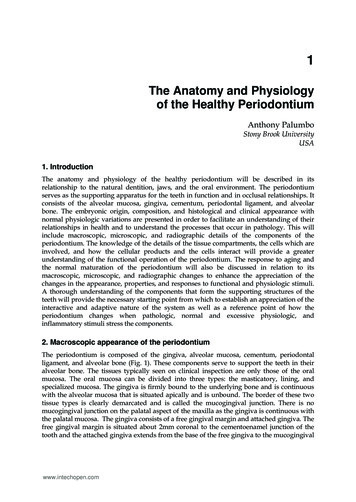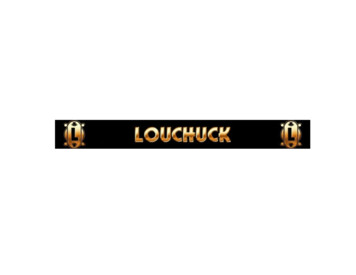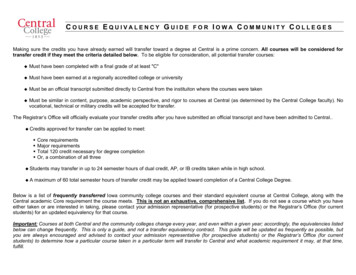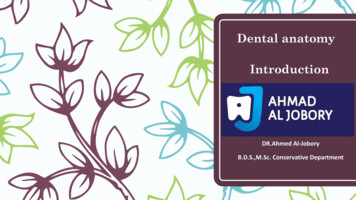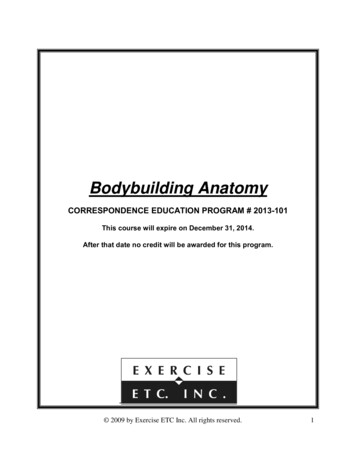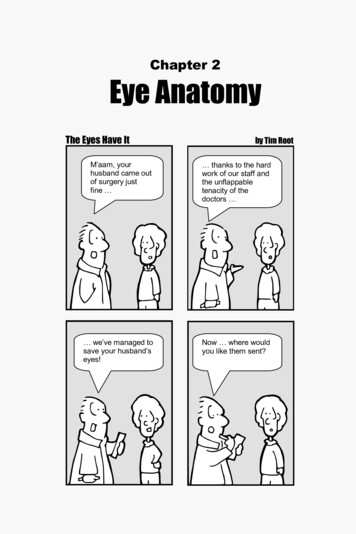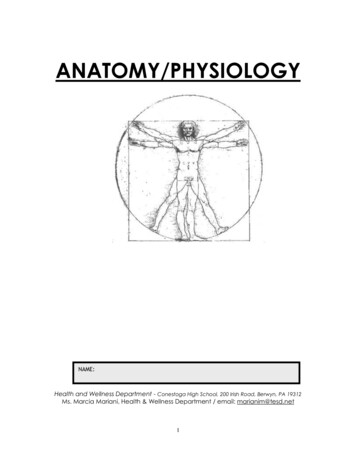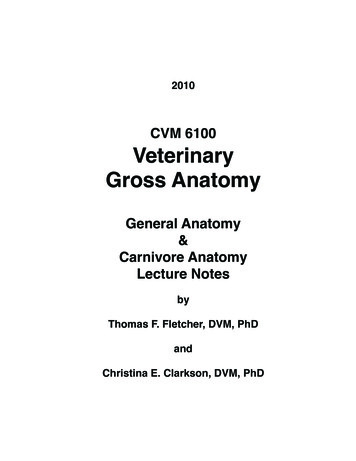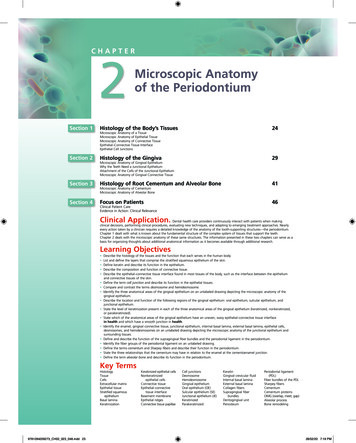
Transcription
CHAPTER2Microscopic Anatomyof the PeriodontiumSection 1Histology of the Body’s Tissues24Section 2Histology of the Gingiva29Section 3Histology of Root Cementum and Alveolar Bone41Section 4Focus on Patients46Microscopic Anatomy of a TissueMicroscopic Anatomy of Epithelial TissueMicroscopic Anatomy of Connective TissueEpithelial–Connective Tissue InterfaceEpithelial Cell JunctionsMicroscopic Anatomy of Gingival EpitheliumWhy the Teeth Need a Junctional EpitheliumAttachment of the Cells of the Junctional EpitheliumMicroscopic Anatomy of Gingival Connective TissueMicroscopic Anatomy of CementumMicroscopic Anatomy of Alveolar BoneClinical Patient CareEvidence in Action: Clinical RelevanceClinical Application. Dental health care providers continuously interact with patients when makingclinical decisions, performing clinical procedures, evaluating new techniques, and adapting to emerging treatment approaches. Nearlyevery action taken by a clinician requires a detailed knowledge of the anatomy of the tooth-supporting structures—the periodontium.Chapter 1 dealt with what is known about the fundamental structure of the complex system of tissues that support the teeth.Chapter 2 deals with the microscopic anatomy of these same structures. The information presented in these two chapters can serve as abasis for organizing thoughts about additional anatomical information as it becomes available through additional research.Learning Objectives Describe the histology of the tissues and the function that each serves in the human body.List and define the layers that comprise the stratified squamous epithelium of the skin.Define keratin and describe its function in the epithelium.Describe the composition and function of connective tissue.Describe the epithelial–connective tissue interface found in most tissues of the body, such as the interface between the epitheliumand connective tissues of the skin.Define the term cell junction and describe its function in the epithelial tissues.Compare and contrast the terms desmosome and hemidesmosome.Identify the three anatomical areas of the gingival epithelium on an unlabeled drawing depicting the microscopic anatomy of thegingival epithelium.Describe the location and function of the following regions of the gingival epithelium: oral epithelium, sulcular epithelium, andjunctional epithelium.State the level of keratinization present in each of the three anatomical areas of the gingival epithelium (keratinized, nonkeratinized,or parakeratinized).State which of the anatomical areas of the gingival epithelium have an uneven, wavy epithelial–connective tissue interfacein health and which have a smooth junction in health.Identify the enamel, gingival connective tissue, junctional epithelium, internal basal lamina, external basal lamina, epithelial cells,desmosomes, and hemidesmosomes on an unlabeled drawing depicting the microscopic anatomy of the junctional epithelium andsurrounding tissues.Define and describe the function of the supragingival fiber bundles and the periodontal ligament in the periodontium.Identify the fiber groups of the periodontal ligament on an unlabeled drawing.Define the terms cementum and Sharpey fibers and describe their function in the periodontium.State the three relationships that the cementum may have in relation to the enamel at the cementoenamel junction.Define the term alveolar bone and describe its function in the periodontium.Key TermsHistologyTissueCellsExtracellular matrixEpithelial tissueStratified squamousepitheliumBasal laminaKeratinization9781284209273 CH02 023 048.indd 23Keratinized epithelial cellsNonkeratinizedepithelial cellsConnective tissueEpithelial–connectivetissue interfaceBasement membraneEpithelial ridgesConnective tissue papillaeCell junctionsDesmosomeHemidesmosomeGingival epitheliumOral epithelium (OE)Sulcular epithelium (SE)Junctional epithelium (JE)KeratinizedParakeratinizedKeratinGingival crevicular fluidInternal basal laminaExternal basal laminaCollagen fibersSupragingival fiberbundlesDentogingival unitPeriosteumPeriodontal ligament(PDL)Fiber bundles of the PDLSharpey fibersCementumCementum proteinsOMG (overlap, meet, gap)Alveolar processBone remodeling28/02/20 7:19 PM
24 Part 1 The Periodontium in HealthSection 1Histology of the Body’s TissuesHistology is a branch of anatomy concerned with the study of the microscopic featuresof tissues. Knowledge of the microscopic characteristics of tissues is a prerequisite forunderstanding the microscopic anatomy of the periodontium. Section 1 reviews themicroscopic anatomy of the epithelial and connective tissues of the body.MICROSCOPIC ANATOMY OF A TISSUEA tissue is a group of interconnected cells that perform a similar function within anorganism. For example, muscle cells group together to form muscle tissue that functionsto move parts of the body. The tissues and organs of the body are composed of severaldifferent types of cells and extracellular elements outside of the cells.1. CellsA. Cells are the smallest structural unit of living matter capable of functioningindependently.B. Cells group together to form a tissue.C. The four basic types of tissue are epithelial, connective, nerve, and muscle tissues.2. Extracellular Matrix. Tissues are not made up solely of cells. A gel-like substancecontaining interwoven protein fibers surrounds most cells.A. The extracellular matrix is a mesh-like material that surrounds the cells (Fig. 2-1).It is like a structural and biomechanical scaffold for the cells. This material helpsto hold cells together and provides a framework within which cells can migrateand interact with one another.B. The extracellular matrix consists of ground substance and fibers.1. The ground substance is a gel-like material that fills the space between the cells.2. The fibers consist of collagen, elastin, and reticular fibers. Collagens are themajor proteins of the extracellular matrix.C. Amount of Extracellular Matrix1. In epithelial tissue, the extracellular matrix is sparse, consisting mainly of a thinmat called the basal lamina, which underlies the epithelium.2. In connective tissue, the extracellular matrix is more plentiful than the cells thatit surrounds.FibroblastExtracellularmatrixMast cellCollagenfiber bundleMacrophagePlasma cellElastic fiberB-lymphocyteFigure 2-1. Extracellular Matrix. The extracellular matrix surrounds the cells of a tissue and is comprised offibers and a gel-like substance.9781284209273 CH02 023 048.indd 2428/02/20 7:19 PM
Chapter 2Microscopic Anatomy of the Periodontium25MICROSCOPIC ANATOMY OF EPITHELIAL TISSUE1. Description. The epithelial tissue is the tissue that makes up the outer surface of thebody (skin or epidermis) and lines the body cavities such as the mouth, stomach, andintestines (mucosa). The skin and mucosa of the oral cavity are made up of stratifiedsquamous epithelium—a type of epithelium that is comprised of flat cells arranged inseveral layers.2. Composition of Epithelial TissueA. Plentiful Cells. Most of the volume of epithelial tissue consists of many closelypacked epithelial cells (Fig. 2-2). Epithelial cells are bound together into sheets.B. Sparse Extracellular Matrix1. The extracellular matrix is a minor component of the epithelial tissue existingmainly in the basal lamina.2. The basal lamina is a thin mat of extracellular matrix secreted by the epithelialcells. This basal lamina mat supports the epithelium (somewhat like thescaffolding of a building).3. Keratinization. Keratinization—the process by which epithelial cells on the surface ofthe skin become stronger and waterproof.A. Keratinized Epithelial Cells1. Keratinized epithelial cells have no nuclei and form a tough, resistant layer onthe surface of the skin.2. The most heavily keratinized epithelium of the body is found on the palms ofthe hands and soles of the feet.B. Nonkeratinized Epithelial Cells1. Nonkeratinized epithelial cells have nuclei and act as a cushion against mechanicalstress and wear. Nonkeratinized epithelial cells are softer and more flexible.2. Nonkeratinized epithelium is found in areas such as the mucosal lining ofthe cheeks—permitting the mobility needed to speak, chew, and make facialexpressions.4. Blood Supply. Epithelial tissues are avascular—containing no blood vessels. Theepithelial layer receives oxygen and nourishment from blood vessels located in theunderlying connective tissue via a process known as diffusion (Fig. 2-2).EpitheliumFigure 2-2. Stratified Squamous Epithelium andConnective Tissue of the Skin. The epithelium ofthe skin consists of many closely packed epithelialcells and a thin basal lamina. The epithelium of theskin rests on a supporting bed of connective tissue.The epithelium does not contain blood vessels;nourishment is received from blood vessels in theunderlying connective tissue.Connectivetissue9781284209273 CH02 023 048.indd 2528/02/20 7:19 PM
26 Part 1 The Periodontium in HealthMICROSCOPIC ANATOMY OF CONNECTIVE TISSUE1. Description. Connective tissue fills the spaces between the tissues and organs in thebody. It supports and binds other tissues. Connective tissue consists of cells separatedby abundant extracellular substance.2. Composition of Connective TissueA. Sparse Cells. Connective tissue cells are sparsely distributed in the extracellularmatrix.1. Fibroblasts (“fiber-builders”)—cells that form the extracellular matrix (fibersand ground substance) and secrete it into the intercellular spaces2. Macrophages and neutrophils—phagocytes (“cell-eaters”) that devour dyingcells and microorganisms that invade the body3. Lymphocytes—cells that play a major role in the immune responseB. Plentiful Extracellular Matrix. The extracellular matrix—a rich gel-like substancecontaining a network of strong fibers—is the major component of connectivetissue. The network of the fiber matrix, rather than the cells, gives connectivetissue the strength to withstand mechanical forces.3. Dental Connective Tissue. All dental tissues of the tooth—cementum, dentin, alveolarbone, and the pulp—are specialized forms of connective tissue except enamel. Enamelis an epithelial tissue.EPITHELIAL–CONNECTIVE TISSUE INTERFACE1. Description. The epithelial–connective tissue interface is the boundary where theepithelial and connective tissues meet.2. The Basement Membrane and Basal LaminaA. As discussed previously, the basal lamina is a thin layer secreted by the epithelialcells on which the epithelium sits. The term basal lamina often is confusedwith the term basement membrane and is sometimes used inconsistently in theliterature.B. The basal lamina is not visible under the light microscope, but can bedistinguished under the higher magnification of an electron microscope. The basallamina assists the attachment of the epithelial cells to adjacent structures, such asthe tooth surface.C. The term basement membrane specifies a thin layer of tissue visible with a lightmicroscope beneath the epithelium. The basement membrane is formed by thecombination of a basal lamina and a reticular lamina.3. Characteristics of the Epithelial–Connective Tissue BoundaryA. Wavy Boundary. In most places in the body, the epithelium meets the connectivetissue in a wavy, uneven manner (Fig. 2-3).1. Epithelial ridges—deep extensions of epithelium that reach down into theconnective tissue. The epithelial ridges are also known as rete pegs.2. Connective tissue papillae—finger-like extensions of connective tissue thatproject up and interlock with the epithelium.B. Smooth Boundary1. Some specialized epithelial tissues in the body meet the connectivetissue in a smooth interface that has no epithelial ridges or connective tissuepapillae.2. Some anatomical areas of the gingiva have an epithelial–connective tissueinterface that is smooth.9781284209273 CH02 023 048.indd 2628/02/20 7:19 PM
Chapter 2EpitheliumEpithelialridgeMicroscopic Anatomy of the Periodontium27Figure 2-3. Wavy Epithelial–ConnectiveTissue Interface. In most cases, theepithelium meets the connective tissue at anuneven, wavy border. Epithelial ridges extenddown into the connective tissue. Connectivetissue papillae extend upward into theepithelium.Wavy sue4. Function of the Wavy Tissue BoundaryA. Enhances Adhesion. The wavy tissue interface enhances the adhesion of theepithelium to the connective tissue by increasing the surface area of the junctionbetween the two tissues. This strong adhesion of the epithelium allows the skin toresist mechanical forces.B. Provides Nourishment. The wavy junction between the epithelium and connectivetissue also increases the area from which the epithelium can receive nourishmentfrom the underlying connective tissue. The epithelium does not have its own bloodsupply; blood vessels are carried close to the epithelium in the connective tissuepapillae.EPITHELIAL CELL JUNCTIONSNeighboring epithelial cells attach to one another by specialized cell junctions that givethe tissue strength to withstand mechanical forces and to form a protective barrier.1. Definition. Cell junctions are cellular structures that mechanically attach a cell and itscytoskeleton to its neighboring cells or to the basal lamina.2. Purpose. Cell junctions bind cells together so that they can function as astrong structural unit. Tissues, such as the epithelium of the skin that mustwithstand severe mechanical stresses, have the most abundant number of celljunctions.3. Types of Epithelial Cell JunctionsA. Desmosome—a specialized cell junction that connects two neighboringepithelial cells and their cytoskeletons together. You might think of desmosomesas being like the snaps used to close a denim jacket. Instead of fastening thefront of a jacket together, desmosomes fasten epithelial cells together(Fig. 2-4A,B).1. A cell-to-cell connection2. An important form of cell junction found in the gingival epitheliumB. Hemidesmosome—a specialized cell junction that connects the epithelial cells tothe basal lamina (Fig. 2-4A,B). You might think of hemidesmosomes as specializedstructures that represent half of a desmosome.1. A cell-to-basal lamina connection2. An important form of cell junction found in the gingival epithelium9781284209273 CH02 023 048.indd 2728/02/20 7:19 PM
28 Part 1 The Periodontium in HealthEpithelial cellsNucleusDesmosomesHemidesmosomesConnective tissueHemidesmosomeBasementmembranezoneBasal laminaReticular laminaAFigure 2-4A. The Epithelial–Connective Tissue Interface. The epithelial–connective tissue interface isthe site of the basement membrane zone, a complex structure mostly synthesized by the epithelial cells.Inset: A representation of an electron micrograph showing the hemidesmosomal attachment to the basallamina. (Adapted with permission from Rubin R, Strayer DS. Rubin’s Pathology: Clinicopathologic Foundationsof Medicine. 5th ed. Philadelphia, PA: Lippincott Williams & Wilkins; 2008.)DesmosomeEpithelial cellsBasal laminaConnectivetissueHemidesmosomeBFigure 2-4B. Epithelial Cell Junctions. Epithelial cells attach to each other with specialized cell junctionscalled desmosomes. Hemidesmosomes attach the epithelial cells to the basal lamina.9781284209273 CH02 023 048.indd 2828/02/20 7:19 PM
Chapter 2Microscopic Anatomy of the Periodontium29Section 2Histology of the GingivaKnowledge of the microscopic anatomy of the gingiva is a prerequisite for understandingthe periodontium in health and in disease. At first glance, the microscopic anatomy of theperiodontium may seem to be complicated.1 The anatomy of the periodontium, however,is much like that of tissues elsewhere in the body. The gingiva consists of an epitheliallayer and an underlying connective tissue layer. This section reviews the microscopicanatomy of the gingival epithelium, junctional epithelium, and gingival connectivetissues.MICROSCOPIC ANATOMY OF GINGIVAL EPITHELIUMThe gingival epithelium is a specialized stratified squamous epithelium that functionswell in the wet environment of the oral cavity.2 The microscopic anatomy of the gingivalepithelium is like that of the epithelium of the skin. The gingival epithelium may bedifferentiated into three anatomical areas (Fig. 2-5):1. Oral Epithelium (OE): epithelium that faces the oral cavity2. Sulcular Epithelium (SE): epithelium that faces the tooth surface without being incontact with the tooth surface3. Junctional Epithelium (JE): epithelium that attaches the gingiva to the toothDent inEn am elFigure 2-5. Three Areas of the Gingival Epithelium. The gingivalepithelium has three distinct areas: JE—junctional epithelium at the base of the sulcus SE—sulcular epithelium that lines the sulcus OE—oral epithelium covering the free and attached gingivaSECEJJEOECementumConnectivetissueBone1. Oral Epithelium (OE). The oral epithelium covers the outer surface of the freegingiva and attached gingiva; it extends from the crest of the gingival margin to themucogingival junction. The oral epithelium is the only part of the periodontium thatis visible to the unaided eye.A. Cellular Structure of the Oral Epithelium (OE)1. The oral epithelium may be keratinized or parakeratinized (partiallykeratinized). Keratin is a tough, fibrous structural protein that occurs in theouter layer of the skin and the oral epithelium (Fig. 2-6).9781284209273 CH02 023 048.indd 2928/02/20 7:19 PM
30 Part 1 The Periodontium in Health2. The oral epithelium is stratified squamous epithelium that can be divided intocell layers (Fig. 2-6). The layers are listed below in order from the deepest layerto the most superficial layer.a. Basal cell layer (stratum basale): cube-shaped cellsb. Prickle cell layer (stratum spinosum): spine-like cells with large intercellularspaces. The cells of both the basal and prickle cell layers attach to eachother with desmosomes.c. Granular cell layer (stratum granulosum): flattened cells and increasedintracellular keratind. Keratinized cell layer (stratum corneum): flattened cells with extensiveintracellular keratin.B. Interface with Gingival Connective Tissue. In health, oral epithelium joins withthe connective tissue in a wavy interface with epithelial ridges (Figs. 2-7 and 2-8).2. Sulcular Epithelium. Sulcular epithelium (SE) is the epithelial lining of the gingivalsulcus. It is continuous with the oral epithelium and extends from the crest of thegingival margin to the coronal edge of the junctional epithelium.A. Cellular Structure of the Sulcular Epithelium (SE)1. The sulcular epithelium is a thin, nonkeratinized epithelium.32. The sulcular epithelium has three cellular layers (Fig. 2-6):a. Basal cell layerb. Prickle cell layerc. Superficial cell layer: flattened cells without keratin3. The sulcular epithelium is permeable allowing fluid to flow from the gingivalconnective tissue into the sulcus. This fluid is known as the gingival crevicularfluid. The flow of gingival crevicular fluid is slight in health and increases indisease.B. Interface with Gingival Connective Tissue. In health, the sulcular epithelium joinsthe connective tissue at a smooth interface with no epithelial ridges (no wavyjunction).3. Junctional Epithelium. Junctional epithelium (JE) is the specialized epitheliumthat forms the base of the sulcus and joins the gingiva to the tooth surface. Thegingiva surrounds the cervix of the tooth and attaches to the tooth by means of thejunctional epithelium. The base of the sulcus is made up of the coronal-most cellsof the junctional epithelium. In health, the JE attaches to the tooth at a level that isslightly coronal to the cementoenamel junction (CEJ).A. Cellular Structure of the Junctional Epithelium (JE)1. Keratinization of JEa. The junctional epithelium is a thin, nonkeratinized epithelium.b. Nonkeratinized epithelial cells of both the sulcular and junctional areasof the gingival epithelium make them a less effective protective covering.Thus, the sulcular and junctional areas provide the easiest point of entry forbacteria or bacterial products to invade the connective tissue of the gingiva.2. The junctional epithelium has only two cell layers (Figs. 2-6 and 2-7):a. Basal cell layerb. Prickle cell layer3. Length and Width of JEa. The junctional epithelium ranges from 0.71 to 1.35 mm in length.4b. The JE is about 15 to 30 cells thick at the coronal zone—the zone thatattaches highest on the crown of the tooth.c. The JE tapers from 4 to 5 cells thick at the apical zone.9781284209273 CH02 023 048.indd 3028/02/20 7:19 PM
Chapter 2Microscopic Anatomy of the Periodontium31B. JE Interface with Gingival Connective Tissue. In health, the junctional epitheliumhas a smooth tissue interface with the connective tissue (no wavy junctions).Oral Epi.KLGLPLBLSulcular Epi.SLPLBLSEJunctional Epi.ToothPLBLOEJEFigure 2-6. Cell Layers of the Gingival Epithelium. The cell layers of the oral, sulcular, and junctionalepithelium. Illustration key: KL, keratinized cell layer; GL, granular cell layer; SL, superficial cell layer; PL, pricklecell layer; BL, basal cell layer.Sulcular epitheliumGingival sulcusOral epitheliumEnamel spaceJunctional epithelumEpithelialridgeFigure 2-7. Human Gingiva. This photograph shows a decalcified longitudinal section of an incisor tooth asseen through an ordinary light microscope. All the calcium hydroxyapatite crystals have been extracted fromthe tooth and from its bony alveolus. Since enamel is composed almost completely of calcium hydroxyapatitecrystals, only the space where enamel used to be—the enamel space—is represented in this photograph.The sulcular epithelium of the free gingiva borders a space known as the gingival sulcus. Observe the welldeveloped epithelial ridges (identified by label and arrows) of the oral epithelium. (Adapted with permissionfrom Gartner LP, Hiatt JL. Color Atlas and Text of Histology. Philadelphia, PA: Lippincott Williams & Wilkins;2013.)9781284209273 CH02 023 048.indd 3128/02/20 7:19 PM
32 Part 1 The Periodontium in HealthEpitheliumEpithelial ridgeConnective tissueCollagen fiberbundlesFigure 2-8. Epithelial Ridges. This photograph shows the epithelial–connective junction as seen throughan ordinary light microscope. The tall epithelial ridges of the epithelium (in dark red) project into theunderlying connective tissue. Collagen fiber bundles are visible in the connective tissue. (Adapted withpermission from Gartner LP, Hiatt JL. Color Atlas and Text of Histology. Philadelphia, PA: Lippincott Williams& Wilkins; 2013.)WHY THE TEETH NEED A JUNCTIONAL EPITHELIUM1. The Teeth Create a Break in the Epithelial Protective CoveringA. Protective Epithelial Sheet Covers the Body1. A continuous sheet of epithelium protects the body by covering its outersurfaces and lining the body’s cavities, including the oral cavity.2. The teeth penetrate this protective covering by erupting through the epithelium,thus creating an opening through which microorganisms can enter the body.B. The Teeth Puncture the Protective Epithelial Sheet1. The body attempts to seal the opening created when a tooth penetrates theepithelium by attaching the epithelium to the tooth.2. The word “junction” means “connection”; thus, the epithelium that isconnected to the tooth is termed the “junctional epithelium.”2. Functions of the Junctional EpitheliumA. Epithelial Attachment. The junctional epithelium provides an attachment betweenthe gingiva and the tooth surface, thus providing a seal at the base of the gingivalsulcus or periodontal pocket (Fig. 2-9).9781284209273 CH02 023 048.indd 3228/02/20 7:19 PM
Chapter 2Microscopic Anatomy of the Periodontium33B. Barrier. The junctional epithelium provides a protective barrier between theplaque biofilm and the connective tissue of the periodontium.C. Host Defense. The epithelial cells play a role in defending the periodontium frombacterial infection by signaling the immune response.5OEEnamelKeratinizedSEFigure 2-9. Microscopic Anatomy of the ThreeAreas of the Gingival Epithelium. Interfacewith Connective Tissue. OE (oral epithelium)—these epithelial cells formthe outer layer of the free and attached gingiva. SE (sulcular epithelium)—these epithelialcells extend from the edge of the junctionalepithelium coronally to the crest of the gingivalmargin.DentinNonkeratinized JE (junctional epithelium)—these epithelial cellsjoin the gingiva to the tooth surface at the baseof the sulcus.Basal celllayer MENT OF THE CELLS OF THE JUNCTIONAL EPITHELIUM1. Microscopic Anatomy of Junctional EpitheliumA. Components of the Junctional Epithelium (JE). The junctional epithelium consistsof:1. Plentiful Cellsa. Layers of closely packed epithelial cellsb. Desmosomes and hemidesmosomes—specialized cell junctions2. A Sparse Extracellular Matrixa. Internal basal lamina—a thin basal lamina between the junctionalepithelium and the tooth surface.b. External basal lamina—a thin basal lamina between the junctionalepithelium and the gingival connective tissue.2. Attachment of Junctional Epithelium to the Tooth SurfaceA. Attachment to the Tooth Surface1. The JE cells next to the tooth surface form hemidesmosomes that enable thesecells to attach to the internal basal lamina and the surface of the tooth.6–99781284209273 CH02 023 048.indd 3328/02/20 7:19 PM
34 Part 1 The Periodontium in Health2. The internal basal lamina is a thin sheet of extracellular matrix adjacent to thetooth surface.3. The epithelial cells physically attach to the tooth surface by four to eighthemidesmosomes per micron at the coronal zone and two hemidesmosomes permicron in the apical zone of the junctional epithelium.10,11 The apical zone isthe area of the junctional epithelium with the least adhesiveness.4. The attachment of the hemidesmosomes and internal basal lamina to the toothsurface is not static; rather, the cells of the junctional epithelium can movealong the tooth surface.B. Attachment to the Underlying Gingival Connective Tissue1. The epithelial cells of the JE attach to the underlying gingival connective tissuevia hemidesmosomes and the external basal lamina (Fig. 2-10).8,12,132. In health, the junctional epithelium has a smooth tissue interface with theconnective tissue (no wavy i-desmosomesInternal basal laminaExternal basal laminaGingival fibersFigure 2-10. Microscopic Anatomy of the Junctional Epithelium (JE). Microscopic structures of thejunctional epithelium include the epithelial cells, desmosomes, external and internal basal laminae, andhemidesmosomes.9781284209273 CH02 023 048.indd 3428/02/20 7:19 PM
Chapter 2Microscopic Anatomy of the Periodontium35MICROSCOPIC ANATOMY OF GINGIVAL CONNECTIVE TISSUE1. Function of Gingival Connective Tissue. The gingival connective tissue of the freeand attached gingiva provides solidity to the gingiva and attaches the gingiva to thecementum of the root and the alveolar bone.14–16 The gingival connective tissue is alsoknown as the lamina propria.2. Components of the Gingival Connective TissueA. Cells1. In contrast to the gingival epithelium (which has an abundance of cells andsparse extracellular matrix), the gingival connective tissue has an abundance ofextracellular matrix and few cells (Fig. 2-11).2. Cells comprise about 5% of the gingival connective tissue.3. The different types of cells present in the gingival connective tissue are:a. Fibroblastsb. Mast cellsc. Immune cells, such as macrophages, neutrophils, and lymphocytes.4. The fibers of the connective tissue are produced by the fibroblasts.B. Extracellular Matrix1. The major components of the connective tissue are collagen fibers, fibroblasts,vessels, and nerves that are embedded in the extracellular matrix. The matrix ofthe connective tissue is produced mainly by the fibroblasts.2. The matrix is the medium in which the connective tissue cells are embeddedand it is essential for the maintenance of the normal function of the connectivetissue. The transportation of water, nutrients, metabolites, oxygen, etc., to andfrom the individual connective tissue cells occurs within the matrix.3. Protein fibers account for about 55% to 65% of the gingival connective tissue.Most of these are collagen fibers that form a dense network of strong, rope-likecables that secure and hold the gingival connective tissues together.4. The collagen fibers enable the gingiva to form a rigid cuff around the tooth.5. Gel-like material between the cells makes up about 30% to 35% of the gingivalconnective tissue. This gel-like material helps to hold the tissue together.Figure 2-11. MicroscopicAnatomy of GingivalConnective Tissue. The gingivalconnective tissue is comprisedof a gel-like substance, proteinfibers, and cells.Epithelial cell sheetBasal laminaMacrophageCapillaryGel-like ground substanceCoF i b ro b l a s tElastin fibersllagbersen fiLymphocyteCDW9781284209273 CH02 023 048.indd 3528/02/20 7:19 PM
36 Part 1 The Periodontium in HealthFigure 2-12. Supragingival Fibers ofGingival Connective Tissue. The gingivalfibers are rope-like collagen fiber bundles inthe gingival connective tissue. These fibersform a soft tissue attachment coronal to thealveolar eliumSupragingivalfibersSoft tissueattachmentBoneCementum3. The Supragingival Fiber Bundles of the Gingival Connective Tissue. The supragingivalfiber bundles (gingival fibers) are a network of rope-like collagen fiber bundles in thegingival connective tissue (Fig. 2-12). These fibers are located coronal to (above) thecrest of the alveolar bone.A. Characteristics of the Fiber Bundles1. The fiber bundles are embedded in the gel-like extracellular matrix of thegingival connective tissue.2. The subgingival fiber bundles strengthen the attachment of the junctionalepithelium to the tooth by bracing the gingival margin against the toothsurface.3. Together the junctional epithelium and the gingival fibers are referred to as thedentog
Histology is a branch of anatomy concerned with the study of the microscopic features of tissues. Knowledge of the microscopic characteristics of tissues is a prerequisite for understanding the microscopic anatomy of the periodontium. Section 1 reviews the microscopic anatomy of the epithelial and connective tissues of the body.
